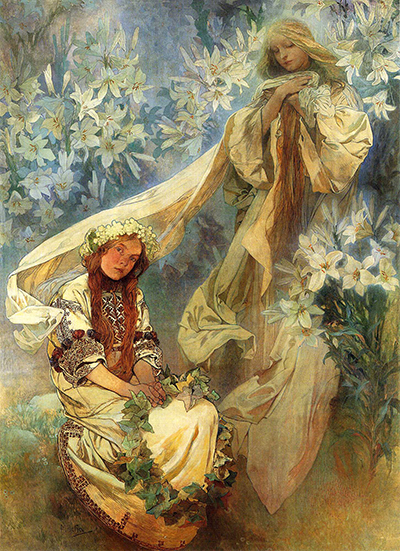A number of different artists have taken on the topic of Madonna of the Lilies in their careers and this memorable piece by Alphonse Mucha was completed in 1905 as part of a larger project commissioned by a church in Jerusalem.
Sadly, the overall project was later cancelled but this particular painting was completed in full and remains a worthy addition to Mucha's oeuvre even on it's own. There were a number of study pieces completed for this painting, one of which was greatily detailed and remains in Japan. The artist also produced a stained-glass window design too, but other elements of the overall project would never get off the ground. The painting found here was to be used as a mural for the church, which explains its large size, with dimensions of 247cm long by 182cm wide.
The lilies represent purity, and who else would this be more appropriate for than the Madonna? The artist is known to have discussed this painting with his wife through written correspondence which underlines its importance to him as well as the logistical impact that this project had on his life, forcing him to be away from his family for an extended period. To summarise his view of this painting, he once described it as 'Virgo purissima'. The background is littered with lilies which leave an undeniable representation that even an occassional art follower should see and understand. The Madonna is accompanied by a young seated girl who is wearing traditional clothing, probably from Slavic culture. She tilts her head to her left, leading the eye towards the Madonna who is lifted upwards, towards the top of the composition.
Many different interpretations have been made of Madonna across a number of different art movements and styles. Two of the finest ones would have to be Madonna of the Pinks by Raphael and Madonna of the Lilies by William-Adolphe Bouguereau. The majority of portraits of this famous religious figure would be found in the Renaissance, where religious art dominated over all other. The major commissions were also mainly offered by those looking to have religious buildings such as churches and cathedrals adorned with the finest art and design possible. They would equally require the finest architecture to host all of these different artworks.




